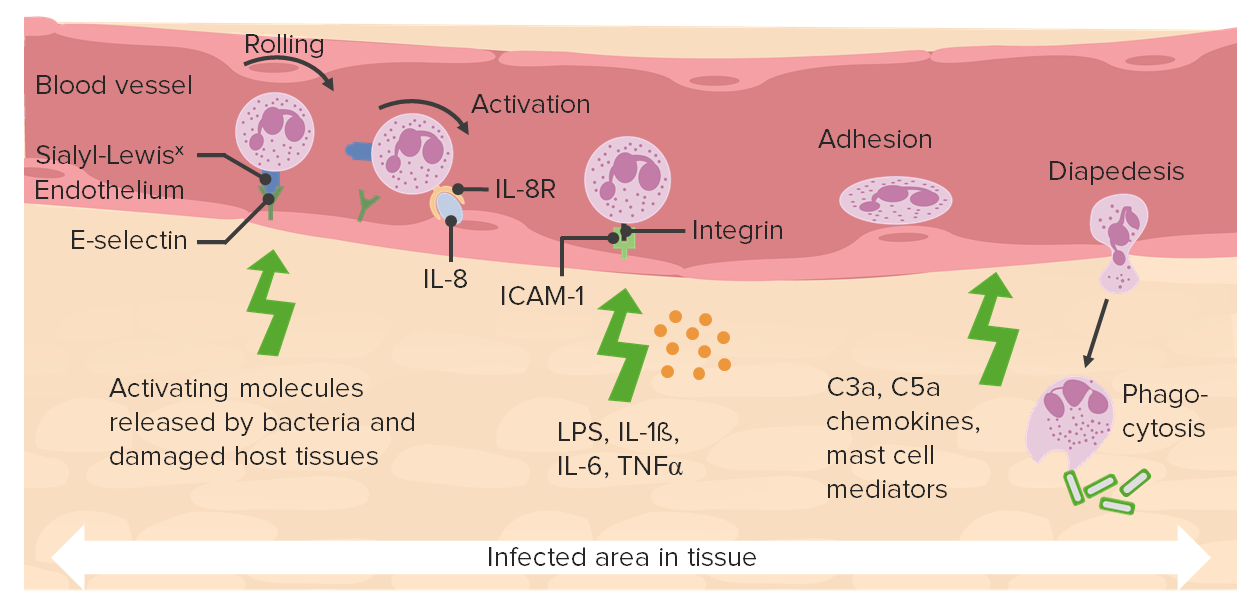Playlist
Show Playlist
Hide Playlist
Sterile Necrosis
-
Slides Acute and Chronic Inflammation Cellular response.pdf
-
Reference List Pathology.pdf
-
Download Lecture Overview
00:01 Okay, that covers infection. 00:05 What about sterile necrosis? So sterile necrosis will also attract and recruit neutrophils, that's part of the early process in acute inflammation and then wound healing. 00:16 So there's no bugs in the sterile necrosis. 00:20 How are we getting them in there? Very pretty story, and actually kind of important to understand. 00:26 So in the tissues, we have macrophages. 00:30 And adjacent to the macrophage, we have some area of tissue necrosis, tissue injury. 00:38 That tissue necrosis will release, because the tissue, the cells are dead, will release danger signals. 00:47 Denature proteins, uric acid, ATP, for example. 00:52 So Danger-associated molecular patterns, DAMPs, as different than PAMPs, will be elaborated by the necrotic tissue. 00:58 And it's basically said, "We're dead." And here is evidence that we're dead. 01:03 And that's something that the macrophages can recognize as one of the major Sentinel cells. 01:09 And ATP is going to be one of the major things. 01:11 So as you see written underneath there, extracellular ATP will stimulate the macrophage to produce interleukin-1-beta. 01:20 At interleukin-1 now is going to be a major mediator. 01:23 So macrophages said, "Oh, there's dead stuff here." I saw the ATP. I'm going to make interleukin-1. 01:29 Interleukin-1 now drives the adhesion molecule expression on the endothelium. 01:35 That intercellular adhesion molecule-1 Okay, now we have a sticky endothelium that we can now recruit neutrophils to bind to. 01:44 So they're halfway there. 01:47 They know that there's something wrong because they're sticking to the endothelium. 01:55 We will also have the macrophages elaborate CXC chemokine. 02:00 Ah, CXC chemokine. 02:01 That's going to be important for recruiting neutrophils by changing the affinity of the integrins. 02:08 Terrific. 02:09 So interleukin 8 is an example of one of the chemokine there are many. 02:12 But now not only I have the leukocytes been rolling, the neutrophils been rolling, they are now firmly adherent to the endothelium in the vicinity of where this damage has happened. 02:23 What's the final chemoattractant signal that gets them to where they need to go? because there's no N-formylmethionine. 02:31 There is no cell wall from a bacteria? How do we get them to where they need to go to clean up the mess? That final step comes from the mitochondria in the dead cells. 02:42 And one of our earlier talks, it all comes back. 02:45 One of our earlier talks, we talked about the fact that mitochondrial proteins because mitochondria derived from prokaryotes, a long time ago. 02:54 Mitochondrial protein synthesis begins with N-formylmethionine. 03:00 Darn, that's exactly what it takes to recruit neutrophils to hit at bacteria, but this informal methionine on peptides is coming from the mitochondria. 03:12 And that's our final chemotactic gradient that gets the neutrophils to into the dead stuff, so that they can degrade it. 03:20 That's a beautiful example. Well, a long way to get there. 03:23 But the same pathways are happening in sterile necrosis too just slightly different signals. 03:30 Very cool. 03:31 Okay, so the neutrophils have arrived, yehey. 03:34 What are they going to do? Well, okay, they're going to eat, number one. 03:38 Number two, they are not just going to eat but they're going to kill and degrade whatever it is that they eat. 03:44 So if they are eating bacteria, or fungus, or other pathogens, they are going to kill it. 03:49 So they've eaten it, and they're going to kill it. 03:51 And they're going to elaborate mediators. 03:54 Those are the three stages that we have to kind of talk about next.
About the Lecture
The lecture Sterile Necrosis by Richard Mitchell, MD, PhD is from the course Acute and Chronic Inflammation.
Included Quiz Questions
How do macrophages recruit neutrophils in sterile necrosis?
- They increase expression of ICAM-1.
- They release histamine and heparin from secretory granules.
- They release ATP.
- They increase interleukin 10 production.
- They release platelet-derived growth factor.
Which of the following acts as a chemoattractant for neutrophils in sterile necrosis?
- Mitochondrial N-formyl-methionine
- Mitochondrial circular DNA
- Nuclear double-stranded DNA
- Mitochondrial calcium ions
- Heat shock proteins
Customer reviews
5,0 of 5 stars
| 5 Stars |
|
5 |
| 4 Stars |
|
0 |
| 3 Stars |
|
0 |
| 2 Stars |
|
0 |
| 1 Star |
|
0 |




